Comprehensive Analysis of Wilson et al.'s Physical Activity Study
VerifiedAdded on 2020/03/16
|14
|5968
|81
Report
AI Summary
This report provides a detailed analysis of the Wilson et al. (2011) study, which investigated interventions to increase physical activity among underserved adolescents in middle school. The study employed a randomized controlled trial design, comparing a motivational and life skills intervention to general health education. The report assesses the study's PICO question, selection bias, study design, control of confounders, and blinding methods. It evaluates the representativeness of the sample, the method of randomization, and the measures taken to minimize biases. The analysis highlights the strengths and weaknesses of the study's methodology, including the handling of confounding variables and the blinding of assessors and participants. The report concludes with an overall assessment of the study's quality and its implications for public health interventions aimed at promoting physical activity in youth.
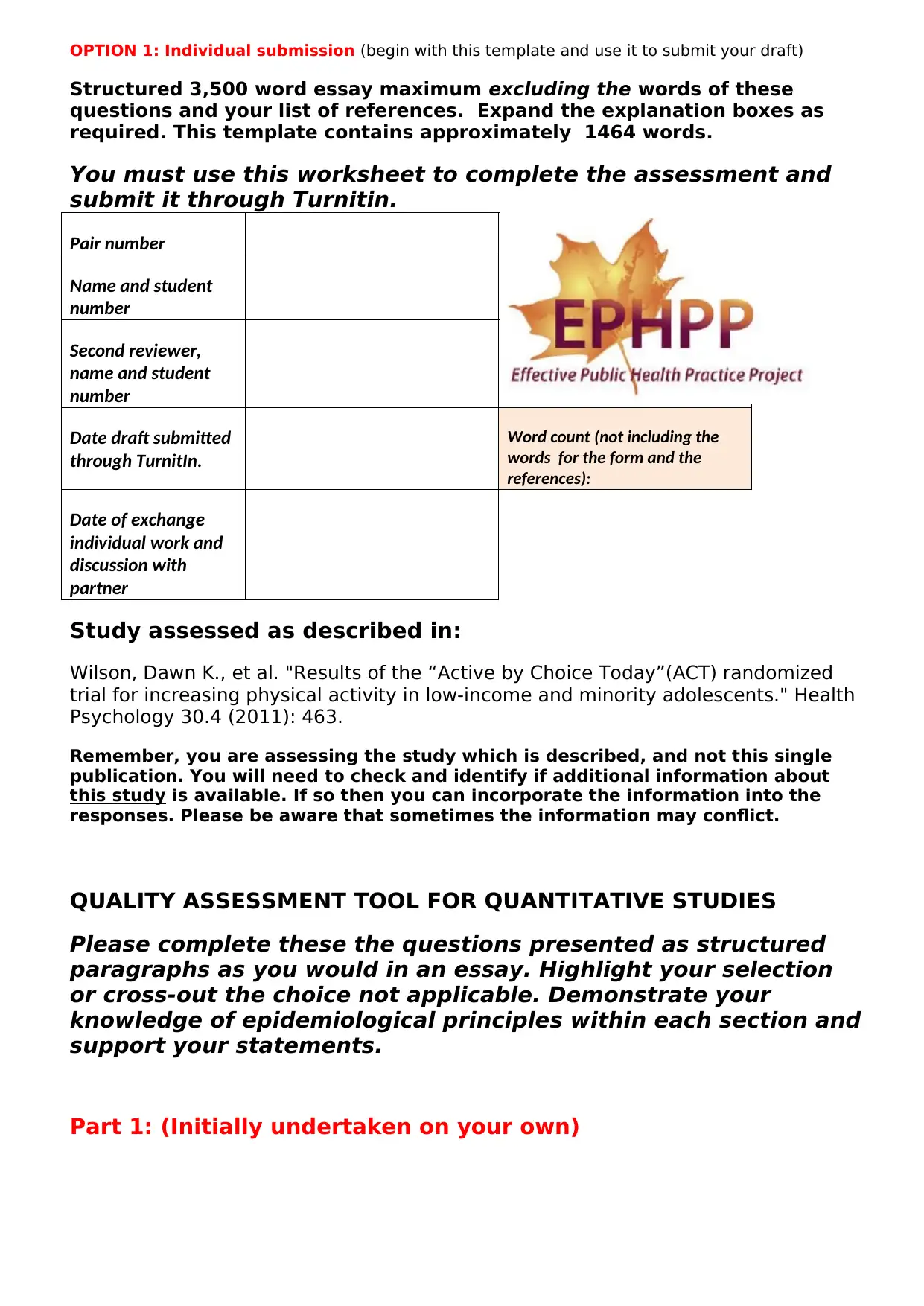
OPTION 1: Individual submission (begin with this template and use it to submit your draft)
Structured 3,500 word essay maximum excluding the words of these
questions and your list of references. Expand the explanation boxes as
required. This template contains approximately 1464 words.
You must use this worksheet to complete the assessment and
submit it through Turnitin.
Pair number
Name and student
number
Second reviewer,
name and student
number
Date draft submitted
through TurnitIn.
Word count (not including the
words for the form and the
references):
Date of exchange
individual work and
discussion with
partner
Study assessed as described in:
Wilson, Dawn K., et al. "Results of the “Active by Choice Today”(ACT) randomized
trial for increasing physical activity in low-income and minority adolescents." Health
Psychology 30.4 (2011): 463.
Remember, you are assessing the study which is described, and not this single
publication. You will need to check and identify if additional information about
this study is available. If so then you can incorporate the information into the
responses. Please be aware that sometimes the information may conflict.
QUALITY ASSESSMENT TOOL FOR QUANTITATIVE STUDIES
Please complete these the questions presented as structured
paragraphs as you would in an essay. Highlight your selection
or cross-out the choice not applicable. Demonstrate your
knowledge of epidemiological principles within each section and
support your statements.
Part 1: (Initially undertaken on your own)
Structured 3,500 word essay maximum excluding the words of these
questions and your list of references. Expand the explanation boxes as
required. This template contains approximately 1464 words.
You must use this worksheet to complete the assessment and
submit it through Turnitin.
Pair number
Name and student
number
Second reviewer,
name and student
number
Date draft submitted
through TurnitIn.
Word count (not including the
words for the form and the
references):
Date of exchange
individual work and
discussion with
partner
Study assessed as described in:
Wilson, Dawn K., et al. "Results of the “Active by Choice Today”(ACT) randomized
trial for increasing physical activity in low-income and minority adolescents." Health
Psychology 30.4 (2011): 463.
Remember, you are assessing the study which is described, and not this single
publication. You will need to check and identify if additional information about
this study is available. If so then you can incorporate the information into the
responses. Please be aware that sometimes the information may conflict.
QUALITY ASSESSMENT TOOL FOR QUANTITATIVE STUDIES
Please complete these the questions presented as structured
paragraphs as you would in an essay. Highlight your selection
or cross-out the choice not applicable. Demonstrate your
knowledge of epidemiological principles within each section and
support your statements.
Part 1: (Initially undertaken on your own)
Paraphrase This Document
Need a fresh take? Get an instant paraphrase of this document with our AI Paraphraser
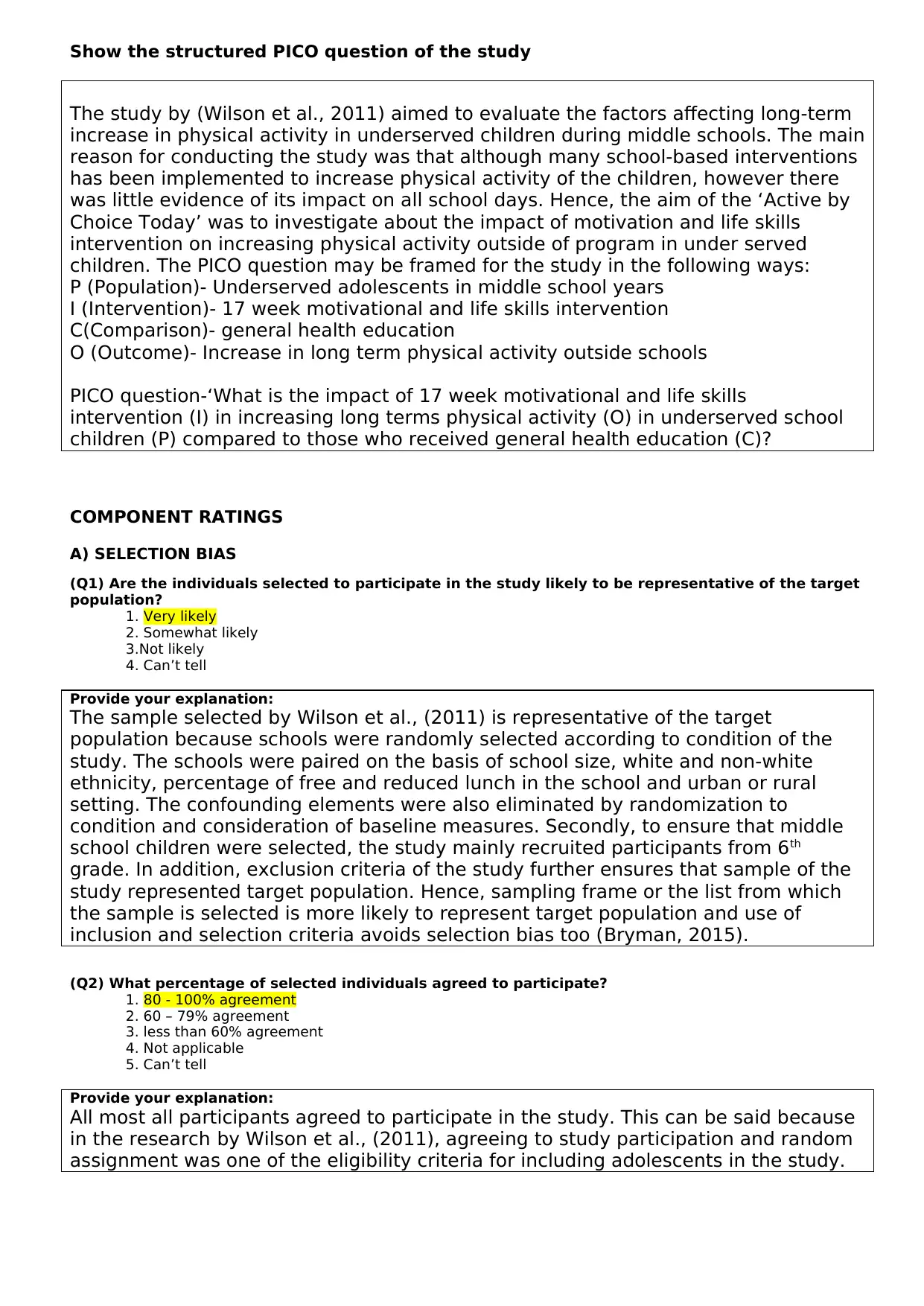
Show the structured PICO question of the study
The study by (Wilson et al., 2011) aimed to evaluate the factors affecting long-term
increase in physical activity in underserved children during middle schools. The main
reason for conducting the study was that although many school-based interventions
has been implemented to increase physical activity of the children, however there
was little evidence of its impact on all school days. Hence, the aim of the ‘Active by
Choice Today’ was to investigate about the impact of motivation and life skills
intervention on increasing physical activity outside of program in under served
children. The PICO question may be framed for the study in the following ways:
P (Population)- Underserved adolescents in middle school years
I (Intervention)- 17 week motivational and life skills intervention
C(Comparison)- general health education
O (Outcome)- Increase in long term physical activity outside schools
PICO question-‘What is the impact of 17 week motivational and life skills
intervention (I) in increasing long terms physical activity (O) in underserved school
children (P) compared to those who received general health education (C)?
COMPONENT RATINGS
A) SELECTION BIAS
(Q1) Are the individuals selected to participate in the study likely to be representative of the target
population?
1. Very likely
2. Somewhat likely
3.Not likely
4. Can’t tell
Provide your explanation:
The sample selected by Wilson et al., (2011) is representative of the target
population because schools were randomly selected according to condition of the
study. The schools were paired on the basis of school size, white and non-white
ethnicity, percentage of free and reduced lunch in the school and urban or rural
setting. The confounding elements were also eliminated by randomization to
condition and consideration of baseline measures. Secondly, to ensure that middle
school children were selected, the study mainly recruited participants from 6th
grade. In addition, exclusion criteria of the study further ensures that sample of the
study represented target population. Hence, sampling frame or the list from which
the sample is selected is more likely to represent target population and use of
inclusion and selection criteria avoids selection bias too (Bryman, 2015).
(Q2) What percentage of selected individuals agreed to participate?
1. 80 - 100% agreement
2. 60 – 79% agreement
3. less than 60% agreement
4. Not applicable
5. Can’t tell
Provide your explanation:
All most all participants agreed to participate in the study. This can be said because
in the research by Wilson et al., (2011), agreeing to study participation and random
assignment was one of the eligibility criteria for including adolescents in the study.
The study by (Wilson et al., 2011) aimed to evaluate the factors affecting long-term
increase in physical activity in underserved children during middle schools. The main
reason for conducting the study was that although many school-based interventions
has been implemented to increase physical activity of the children, however there
was little evidence of its impact on all school days. Hence, the aim of the ‘Active by
Choice Today’ was to investigate about the impact of motivation and life skills
intervention on increasing physical activity outside of program in under served
children. The PICO question may be framed for the study in the following ways:
P (Population)- Underserved adolescents in middle school years
I (Intervention)- 17 week motivational and life skills intervention
C(Comparison)- general health education
O (Outcome)- Increase in long term physical activity outside schools
PICO question-‘What is the impact of 17 week motivational and life skills
intervention (I) in increasing long terms physical activity (O) in underserved school
children (P) compared to those who received general health education (C)?
COMPONENT RATINGS
A) SELECTION BIAS
(Q1) Are the individuals selected to participate in the study likely to be representative of the target
population?
1. Very likely
2. Somewhat likely
3.Not likely
4. Can’t tell
Provide your explanation:
The sample selected by Wilson et al., (2011) is representative of the target
population because schools were randomly selected according to condition of the
study. The schools were paired on the basis of school size, white and non-white
ethnicity, percentage of free and reduced lunch in the school and urban or rural
setting. The confounding elements were also eliminated by randomization to
condition and consideration of baseline measures. Secondly, to ensure that middle
school children were selected, the study mainly recruited participants from 6th
grade. In addition, exclusion criteria of the study further ensures that sample of the
study represented target population. Hence, sampling frame or the list from which
the sample is selected is more likely to represent target population and use of
inclusion and selection criteria avoids selection bias too (Bryman, 2015).
(Q2) What percentage of selected individuals agreed to participate?
1. 80 - 100% agreement
2. 60 – 79% agreement
3. less than 60% agreement
4. Not applicable
5. Can’t tell
Provide your explanation:
All most all participants agreed to participate in the study. This can be said because
in the research by Wilson et al., (2011), agreeing to study participation and random
assignment was one of the eligibility criteria for including adolescents in the study.
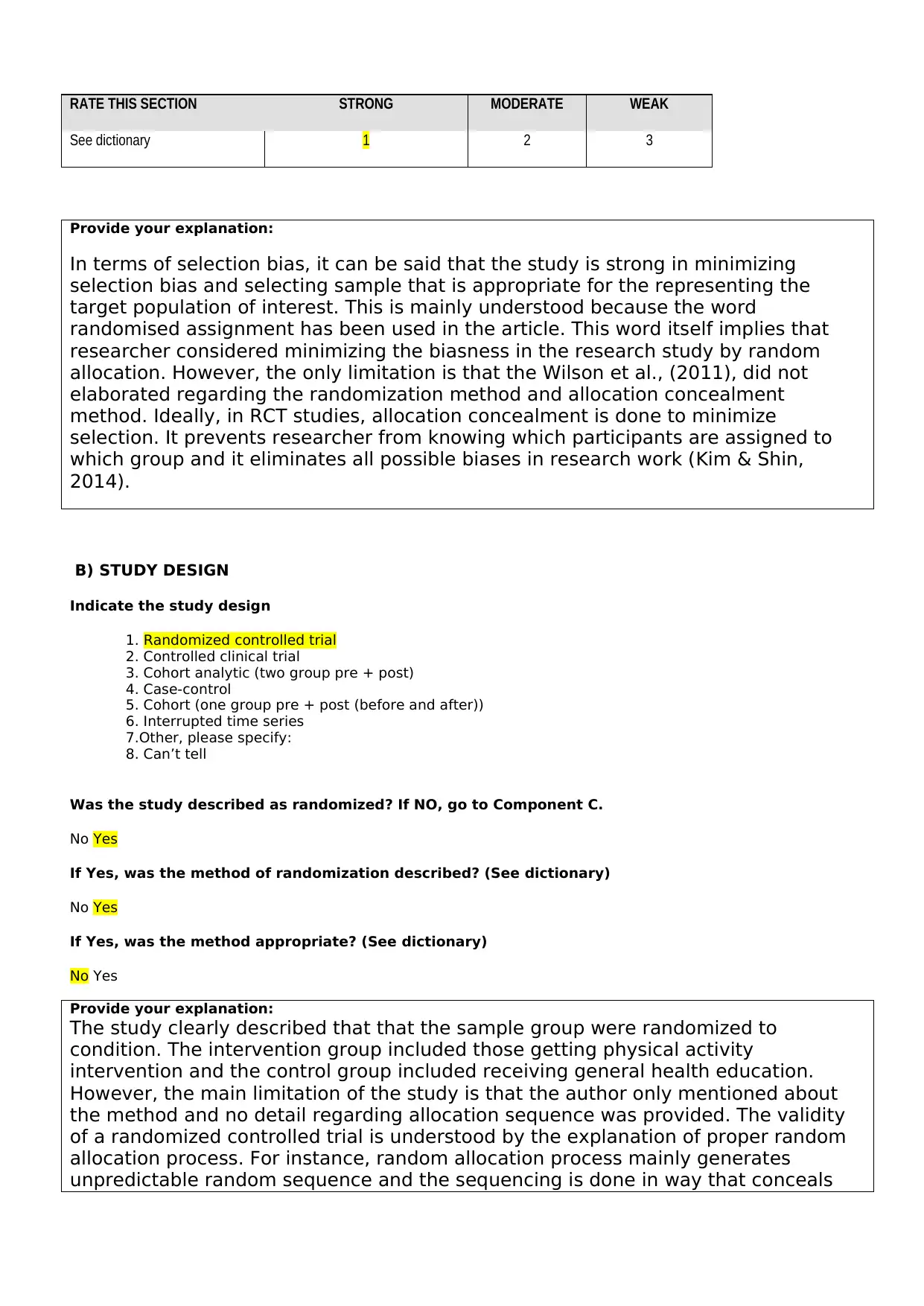
RATE THIS SECTION STRONG MODERATE WEAK
See dictionary 1 2 3
Provide your explanation:
In terms of selection bias, it can be said that the study is strong in minimizing
selection bias and selecting sample that is appropriate for the representing the
target population of interest. This is mainly understood because the word
randomised assignment has been used in the article. This word itself implies that
researcher considered minimizing the biasness in the research study by random
allocation. However, the only limitation is that the Wilson et al., (2011), did not
elaborated regarding the randomization method and allocation concealment
method. Ideally, in RCT studies, allocation concealment is done to minimize
selection. It prevents researcher from knowing which participants are assigned to
which group and it eliminates all possible biases in research work (Kim & Shin,
2014).
B) STUDY DESIGN
Indicate the study design
1. Randomized controlled trial
2. Controlled clinical trial
3. Cohort analytic (two group pre + post)
4. Case-control
5. Cohort (one group pre + post (before and after))
6. Interrupted time series
7.Other, please specify:
8. Can’t tell
Was the study described as randomized? If NO, go to Component C.
No Yes
If Yes, was the method of randomization described? (See dictionary)
No Yes
If Yes, was the method appropriate? (See dictionary)
No Yes
Provide your explanation:
The study clearly described that that the sample group were randomized to
condition. The intervention group included those getting physical activity
intervention and the control group included receiving general health education.
However, the main limitation of the study is that the author only mentioned about
the method and no detail regarding allocation sequence was provided. The validity
of a randomized controlled trial is understood by the explanation of proper random
allocation process. For instance, random allocation process mainly generates
unpredictable random sequence and the sequencing is done in way that conceals
See dictionary 1 2 3
Provide your explanation:
In terms of selection bias, it can be said that the study is strong in minimizing
selection bias and selecting sample that is appropriate for the representing the
target population of interest. This is mainly understood because the word
randomised assignment has been used in the article. This word itself implies that
researcher considered minimizing the biasness in the research study by random
allocation. However, the only limitation is that the Wilson et al., (2011), did not
elaborated regarding the randomization method and allocation concealment
method. Ideally, in RCT studies, allocation concealment is done to minimize
selection. It prevents researcher from knowing which participants are assigned to
which group and it eliminates all possible biases in research work (Kim & Shin,
2014).
B) STUDY DESIGN
Indicate the study design
1. Randomized controlled trial
2. Controlled clinical trial
3. Cohort analytic (two group pre + post)
4. Case-control
5. Cohort (one group pre + post (before and after))
6. Interrupted time series
7.Other, please specify:
8. Can’t tell
Was the study described as randomized? If NO, go to Component C.
No Yes
If Yes, was the method of randomization described? (See dictionary)
No Yes
If Yes, was the method appropriate? (See dictionary)
No Yes
Provide your explanation:
The study clearly described that that the sample group were randomized to
condition. The intervention group included those getting physical activity
intervention and the control group included receiving general health education.
However, the main limitation of the study is that the author only mentioned about
the method and no detail regarding allocation sequence was provided. The validity
of a randomized controlled trial is understood by the explanation of proper random
allocation process. For instance, random allocation process mainly generates
unpredictable random sequence and the sequencing is done in way that conceals
⊘ This is a preview!⊘
Do you want full access?
Subscribe today to unlock all pages.

Trusted by 1+ million students worldwide
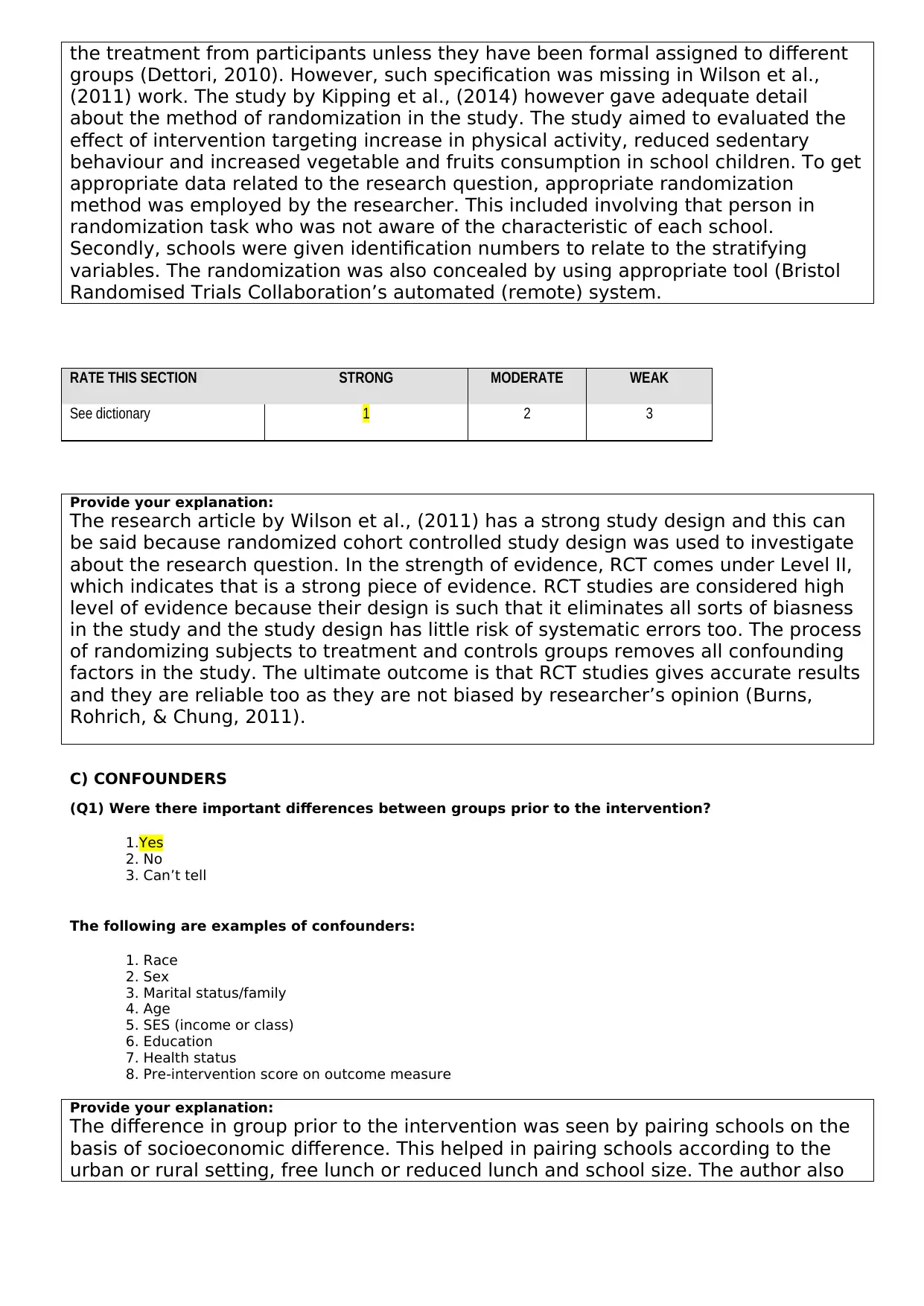
the treatment from participants unless they have been formal assigned to different
groups (Dettori, 2010). However, such specification was missing in Wilson et al.,
(2011) work. The study by Kipping et al., (2014) however gave adequate detail
about the method of randomization in the study. The study aimed to evaluated the
effect of intervention targeting increase in physical activity, reduced sedentary
behaviour and increased vegetable and fruits consumption in school children. To get
appropriate data related to the research question, appropriate randomization
method was employed by the researcher. This included involving that person in
randomization task who was not aware of the characteristic of each school.
Secondly, schools were given identification numbers to relate to the stratifying
variables. The randomization was also concealed by using appropriate tool (Bristol
Randomised Trials Collaboration’s automated (remote) system.
RATE THIS SECTION STRONG MODERATE WEAK
See dictionary 1 2 3
Provide your explanation:
The research article by Wilson et al., (2011) has a strong study design and this can
be said because randomized cohort controlled study design was used to investigate
about the research question. In the strength of evidence, RCT comes under Level II,
which indicates that is a strong piece of evidence. RCT studies are considered high
level of evidence because their design is such that it eliminates all sorts of biasness
in the study and the study design has little risk of systematic errors too. The process
of randomizing subjects to treatment and controls groups removes all confounding
factors in the study. The ultimate outcome is that RCT studies gives accurate results
and they are reliable too as they are not biased by researcher’s opinion (Burns,
Rohrich, & Chung, 2011).
C) CONFOUNDERS
(Q1) Were there important differences between groups prior to the intervention?
1.Yes
2. No
3. Can’t tell
The following are examples of confounders:
1. Race
2. Sex
3. Marital status/family
4. Age
5. SES (income or class)
6. Education
7. Health status
8. Pre-intervention score on outcome measure
Provide your explanation:
The difference in group prior to the intervention was seen by pairing schools on the
basis of socioeconomic difference. This helped in pairing schools according to the
urban or rural setting, free lunch or reduced lunch and school size. The author also
groups (Dettori, 2010). However, such specification was missing in Wilson et al.,
(2011) work. The study by Kipping et al., (2014) however gave adequate detail
about the method of randomization in the study. The study aimed to evaluated the
effect of intervention targeting increase in physical activity, reduced sedentary
behaviour and increased vegetable and fruits consumption in school children. To get
appropriate data related to the research question, appropriate randomization
method was employed by the researcher. This included involving that person in
randomization task who was not aware of the characteristic of each school.
Secondly, schools were given identification numbers to relate to the stratifying
variables. The randomization was also concealed by using appropriate tool (Bristol
Randomised Trials Collaboration’s automated (remote) system.
RATE THIS SECTION STRONG MODERATE WEAK
See dictionary 1 2 3
Provide your explanation:
The research article by Wilson et al., (2011) has a strong study design and this can
be said because randomized cohort controlled study design was used to investigate
about the research question. In the strength of evidence, RCT comes under Level II,
which indicates that is a strong piece of evidence. RCT studies are considered high
level of evidence because their design is such that it eliminates all sorts of biasness
in the study and the study design has little risk of systematic errors too. The process
of randomizing subjects to treatment and controls groups removes all confounding
factors in the study. The ultimate outcome is that RCT studies gives accurate results
and they are reliable too as they are not biased by researcher’s opinion (Burns,
Rohrich, & Chung, 2011).
C) CONFOUNDERS
(Q1) Were there important differences between groups prior to the intervention?
1.Yes
2. No
3. Can’t tell
The following are examples of confounders:
1. Race
2. Sex
3. Marital status/family
4. Age
5. SES (income or class)
6. Education
7. Health status
8. Pre-intervention score on outcome measure
Provide your explanation:
The difference in group prior to the intervention was seen by pairing schools on the
basis of socioeconomic difference. This helped in pairing schools according to the
urban or rural setting, free lunch or reduced lunch and school size. The author also
Paraphrase This Document
Need a fresh take? Get an instant paraphrase of this document with our AI Paraphraser
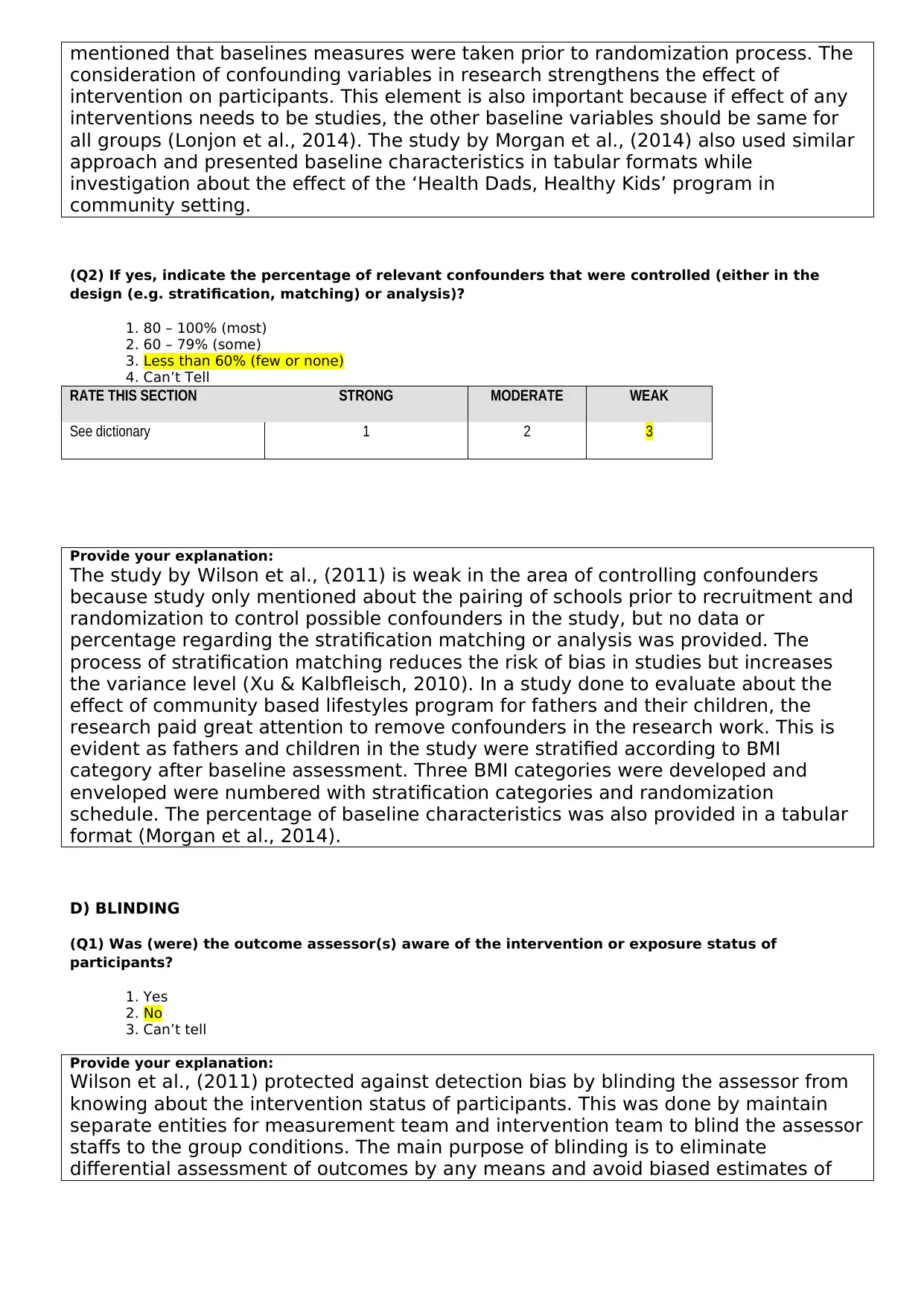
mentioned that baselines measures were taken prior to randomization process. The
consideration of confounding variables in research strengthens the effect of
intervention on participants. This element is also important because if effect of any
interventions needs to be studies, the other baseline variables should be same for
all groups (Lonjon et al., 2014). The study by Morgan et al., (2014) also used similar
approach and presented baseline characteristics in tabular formats while
investigation about the effect of the ‘Health Dads, Healthy Kids’ program in
community setting.
(Q2) If yes, indicate the percentage of relevant confounders that were controlled (either in the
design (e.g. stratification, matching) or analysis)?
1. 80 – 100% (most)
2. 60 – 79% (some)
3. Less than 60% (few or none)
4. Can’t Tell
RATE THIS SECTION STRONG MODERATE WEAK
See dictionary 1 2 3
Provide your explanation:
The study by Wilson et al., (2011) is weak in the area of controlling confounders
because study only mentioned about the pairing of schools prior to recruitment and
randomization to control possible confounders in the study, but no data or
percentage regarding the stratification matching or analysis was provided. The
process of stratification matching reduces the risk of bias in studies but increases
the variance level (Xu & Kalbfleisch, 2010). In a study done to evaluate about the
effect of community based lifestyles program for fathers and their children, the
research paid great attention to remove confounders in the research work. This is
evident as fathers and children in the study were stratified according to BMI
category after baseline assessment. Three BMI categories were developed and
enveloped were numbered with stratification categories and randomization
schedule. The percentage of baseline characteristics was also provided in a tabular
format (Morgan et al., 2014).
D) BLINDING
(Q1) Was (were) the outcome assessor(s) aware of the intervention or exposure status of
participants?
1. Yes
2. No
3. Can’t tell
Provide your explanation:
Wilson et al., (2011) protected against detection bias by blinding the assessor from
knowing about the intervention status of participants. This was done by maintain
separate entities for measurement team and intervention team to blind the assessor
staffs to the group conditions. The main purpose of blinding is to eliminate
differential assessment of outcomes by any means and avoid biased estimates of
consideration of confounding variables in research strengthens the effect of
intervention on participants. This element is also important because if effect of any
interventions needs to be studies, the other baseline variables should be same for
all groups (Lonjon et al., 2014). The study by Morgan et al., (2014) also used similar
approach and presented baseline characteristics in tabular formats while
investigation about the effect of the ‘Health Dads, Healthy Kids’ program in
community setting.
(Q2) If yes, indicate the percentage of relevant confounders that were controlled (either in the
design (e.g. stratification, matching) or analysis)?
1. 80 – 100% (most)
2. 60 – 79% (some)
3. Less than 60% (few or none)
4. Can’t Tell
RATE THIS SECTION STRONG MODERATE WEAK
See dictionary 1 2 3
Provide your explanation:
The study by Wilson et al., (2011) is weak in the area of controlling confounders
because study only mentioned about the pairing of schools prior to recruitment and
randomization to control possible confounders in the study, but no data or
percentage regarding the stratification matching or analysis was provided. The
process of stratification matching reduces the risk of bias in studies but increases
the variance level (Xu & Kalbfleisch, 2010). In a study done to evaluate about the
effect of community based lifestyles program for fathers and their children, the
research paid great attention to remove confounders in the research work. This is
evident as fathers and children in the study were stratified according to BMI
category after baseline assessment. Three BMI categories were developed and
enveloped were numbered with stratification categories and randomization
schedule. The percentage of baseline characteristics was also provided in a tabular
format (Morgan et al., 2014).
D) BLINDING
(Q1) Was (were) the outcome assessor(s) aware of the intervention or exposure status of
participants?
1. Yes
2. No
3. Can’t tell
Provide your explanation:
Wilson et al., (2011) protected against detection bias by blinding the assessor from
knowing about the intervention status of participants. This was done by maintain
separate entities for measurement team and intervention team to blind the assessor
staffs to the group conditions. The main purpose of blinding is to eliminate
differential assessment of outcomes by any means and avoid biased estimates of
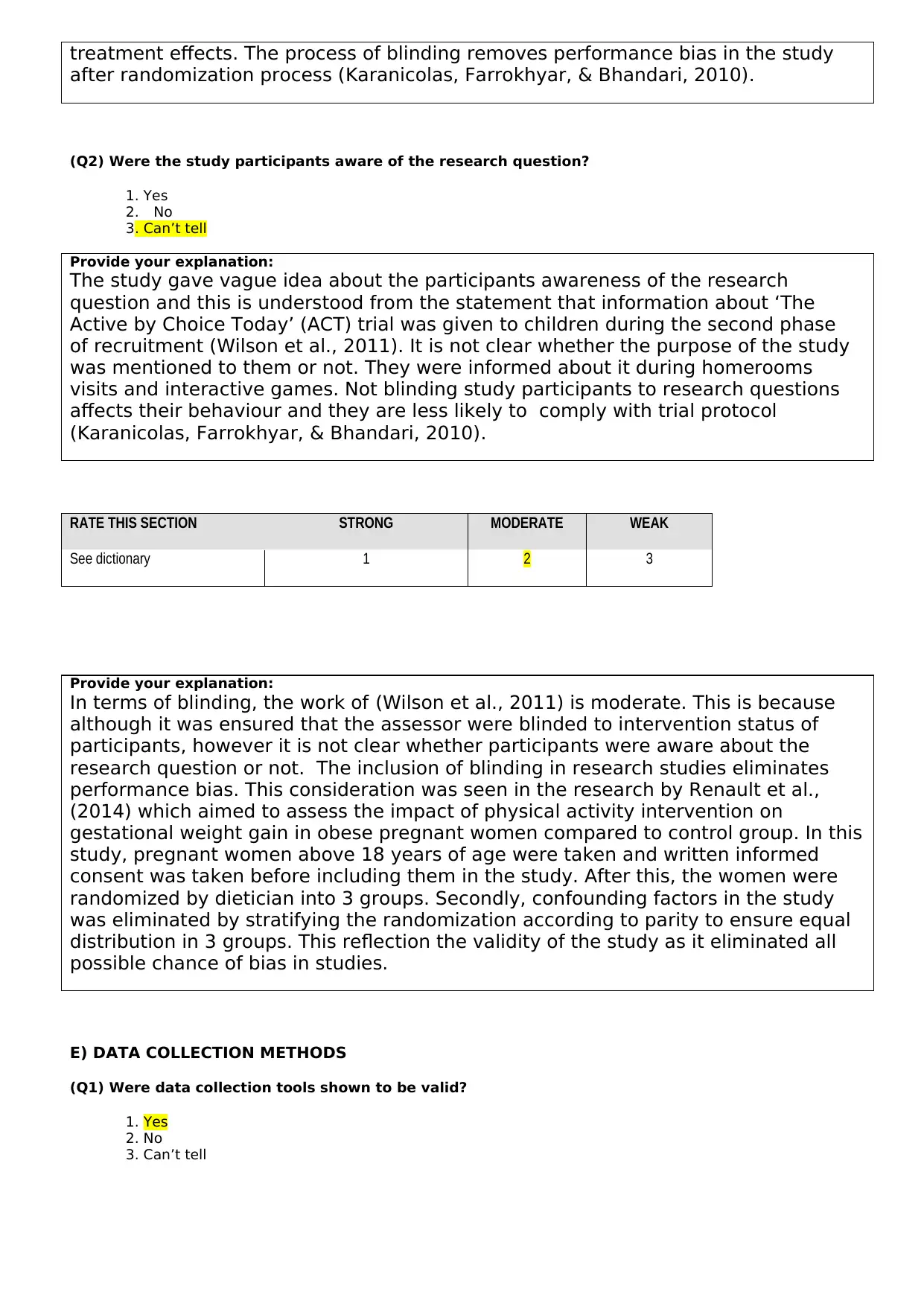
treatment effects. The process of blinding removes performance bias in the study
after randomization process (Karanicolas, Farrokhyar, & Bhandari, 2010).
(Q2) Were the study participants aware of the research question?
1. Yes
2. No
3. Can’t tell
Provide your explanation:
The study gave vague idea about the participants awareness of the research
question and this is understood from the statement that information about ‘The
Active by Choice Today’ (ACT) trial was given to children during the second phase
of recruitment (Wilson et al., 2011). It is not clear whether the purpose of the study
was mentioned to them or not. They were informed about it during homerooms
visits and interactive games. Not blinding study participants to research questions
affects their behaviour and they are less likely to comply with trial protocol
(Karanicolas, Farrokhyar, & Bhandari, 2010).
RATE THIS SECTION STRONG MODERATE WEAK
See dictionary 1 2 3
Provide your explanation:
In terms of blinding, the work of (Wilson et al., 2011) is moderate. This is because
although it was ensured that the assessor were blinded to intervention status of
participants, however it is not clear whether participants were aware about the
research question or not. The inclusion of blinding in research studies eliminates
performance bias. This consideration was seen in the research by Renault et al.,
(2014) which aimed to assess the impact of physical activity intervention on
gestational weight gain in obese pregnant women compared to control group. In this
study, pregnant women above 18 years of age were taken and written informed
consent was taken before including them in the study. After this, the women were
randomized by dietician into 3 groups. Secondly, confounding factors in the study
was eliminated by stratifying the randomization according to parity to ensure equal
distribution in 3 groups. This reflection the validity of the study as it eliminated all
possible chance of bias in studies.
E) DATA COLLECTION METHODS
(Q1) Were data collection tools shown to be valid?
1. Yes
2. No
3. Can’t tell
after randomization process (Karanicolas, Farrokhyar, & Bhandari, 2010).
(Q2) Were the study participants aware of the research question?
1. Yes
2. No
3. Can’t tell
Provide your explanation:
The study gave vague idea about the participants awareness of the research
question and this is understood from the statement that information about ‘The
Active by Choice Today’ (ACT) trial was given to children during the second phase
of recruitment (Wilson et al., 2011). It is not clear whether the purpose of the study
was mentioned to them or not. They were informed about it during homerooms
visits and interactive games. Not blinding study participants to research questions
affects their behaviour and they are less likely to comply with trial protocol
(Karanicolas, Farrokhyar, & Bhandari, 2010).
RATE THIS SECTION STRONG MODERATE WEAK
See dictionary 1 2 3
Provide your explanation:
In terms of blinding, the work of (Wilson et al., 2011) is moderate. This is because
although it was ensured that the assessor were blinded to intervention status of
participants, however it is not clear whether participants were aware about the
research question or not. The inclusion of blinding in research studies eliminates
performance bias. This consideration was seen in the research by Renault et al.,
(2014) which aimed to assess the impact of physical activity intervention on
gestational weight gain in obese pregnant women compared to control group. In this
study, pregnant women above 18 years of age were taken and written informed
consent was taken before including them in the study. After this, the women were
randomized by dietician into 3 groups. Secondly, confounding factors in the study
was eliminated by stratifying the randomization according to parity to ensure equal
distribution in 3 groups. This reflection the validity of the study as it eliminated all
possible chance of bias in studies.
E) DATA COLLECTION METHODS
(Q1) Were data collection tools shown to be valid?
1. Yes
2. No
3. Can’t tell
⊘ This is a preview!⊘
Do you want full access?
Subscribe today to unlock all pages.

Trusted by 1+ million students worldwide

Provide your explanation:
The data collection in Wilson et al., (2011) is shown to be valid because objective
data has been collected by the investigator. The participants in the ACT intervention
were mainly given 17 week intervention related to positive coping strategies for
increasing physical activity outside programs days. On the other hand, the General
Health Education Program focused on nutrition, drug prevention and stress
management. Both formative and summative data were collected from both groups.
This was collected by means of trained intervention staff.
(Q2) Were data collection tools shown to be reliable?
1. Yes
2. No
3. Can’t tell
Provide your explanation:
The data collection process is shown to be reliable as it is based on observation of
groups post the intervention. The collection of summative data by trained
independent evaluators using systematic observation of after school program
activity was an important step as it helped to assess the fidelity of intervention and
the reach of the intervention into the target population. The data collection was
done not only through observation, but also by use of quantitative checklist and
rating scales. This helped to determine the factors that were achieved after the
implementation of the program.
RATE THIS SECTION STRONG MODERATE WEAK
See dictionary 1 2 3
Provide your explanation:
Overall, the data collection tool used in the study can be regarded as a strong tool
because use of systematic observation added to the reliability and validity of the
data collection methods. This can be said because the process that is used for
systematic observation ensures that bias is removed in the study. Wilson et al.,
(2011) particularly eliminated any confounding factor in the study because
independent process evaluator were recruited to collect and analyse the data. As
the main goal of the study was to evaluate participant’s behaviour outside physical
activity program, observation was the most appropriate method to gain answer to
the research question. Another strength of systematic observation is that it
strengthens the richness of the study data. The only weakness is data, reliability and
richness of data is mainly dependent on the experience of the observer (Webster,
2015).
F) WITHDRAWALS AND DROP-OUTS
(Q1) Were withdrawals and drop-outs reported in terms of numbers and/or reasons per group?
1. Yes
2. No
3. Can’t tell
The data collection in Wilson et al., (2011) is shown to be valid because objective
data has been collected by the investigator. The participants in the ACT intervention
were mainly given 17 week intervention related to positive coping strategies for
increasing physical activity outside programs days. On the other hand, the General
Health Education Program focused on nutrition, drug prevention and stress
management. Both formative and summative data were collected from both groups.
This was collected by means of trained intervention staff.
(Q2) Were data collection tools shown to be reliable?
1. Yes
2. No
3. Can’t tell
Provide your explanation:
The data collection process is shown to be reliable as it is based on observation of
groups post the intervention. The collection of summative data by trained
independent evaluators using systematic observation of after school program
activity was an important step as it helped to assess the fidelity of intervention and
the reach of the intervention into the target population. The data collection was
done not only through observation, but also by use of quantitative checklist and
rating scales. This helped to determine the factors that were achieved after the
implementation of the program.
RATE THIS SECTION STRONG MODERATE WEAK
See dictionary 1 2 3
Provide your explanation:
Overall, the data collection tool used in the study can be regarded as a strong tool
because use of systematic observation added to the reliability and validity of the
data collection methods. This can be said because the process that is used for
systematic observation ensures that bias is removed in the study. Wilson et al.,
(2011) particularly eliminated any confounding factor in the study because
independent process evaluator were recruited to collect and analyse the data. As
the main goal of the study was to evaluate participant’s behaviour outside physical
activity program, observation was the most appropriate method to gain answer to
the research question. Another strength of systematic observation is that it
strengthens the richness of the study data. The only weakness is data, reliability and
richness of data is mainly dependent on the experience of the observer (Webster,
2015).
F) WITHDRAWALS AND DROP-OUTS
(Q1) Were withdrawals and drop-outs reported in terms of numbers and/or reasons per group?
1. Yes
2. No
3. Can’t tell
Paraphrase This Document
Need a fresh take? Get an instant paraphrase of this document with our AI Paraphraser
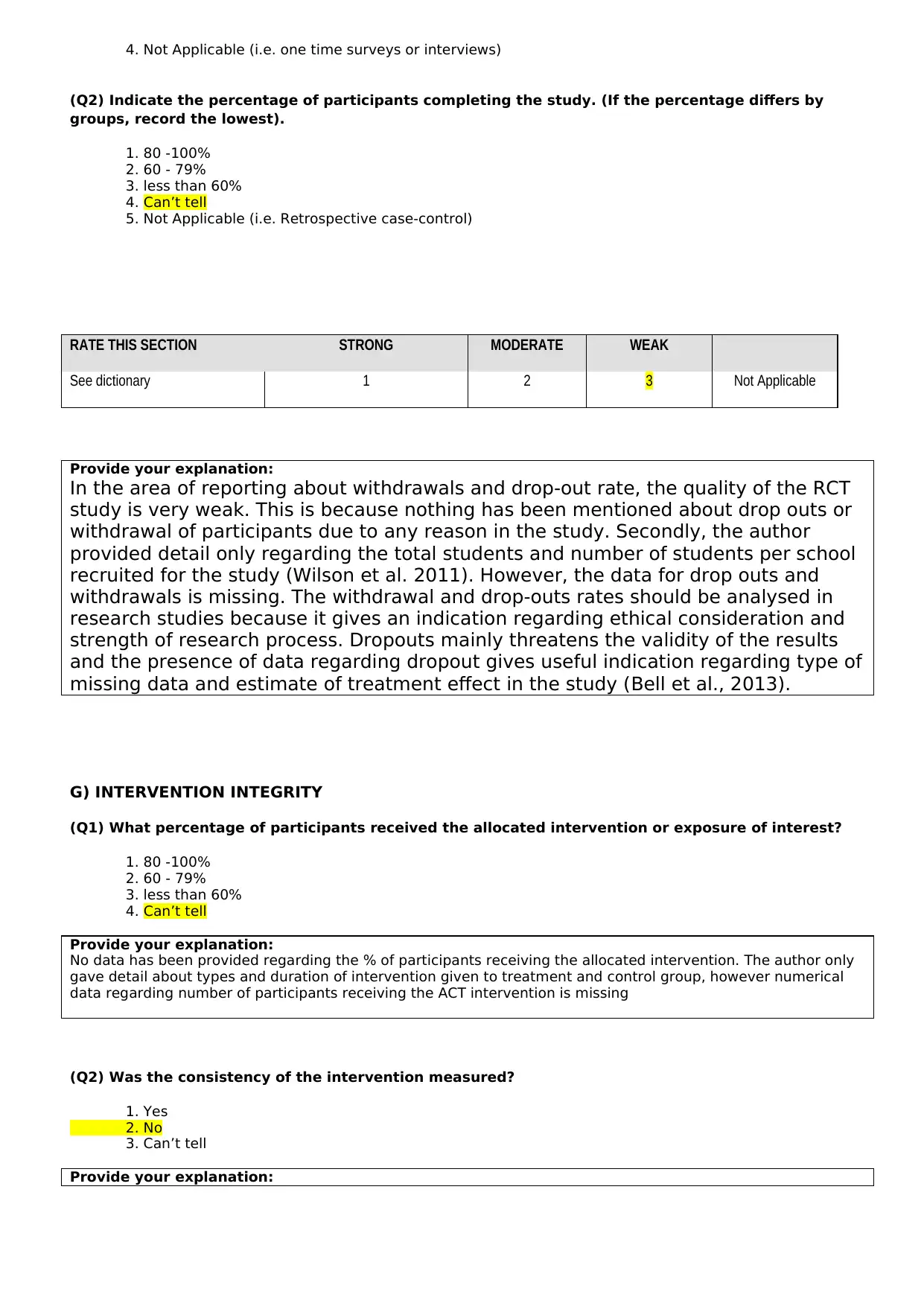
4. Not Applicable (i.e. one time surveys or interviews)
(Q2) Indicate the percentage of participants completing the study. (If the percentage differs by
groups, record the lowest).
1. 80 -100%
2. 60 - 79%
3. less than 60%
4. Can’t tell
5. Not Applicable (i.e. Retrospective case-control)
RATE THIS SECTION STRONG MODERATE WEAK
See dictionary 1 2 3 Not Applicable
Provide your explanation:
In the area of reporting about withdrawals and drop-out rate, the quality of the RCT
study is very weak. This is because nothing has been mentioned about drop outs or
withdrawal of participants due to any reason in the study. Secondly, the author
provided detail only regarding the total students and number of students per school
recruited for the study (Wilson et al. 2011). However, the data for drop outs and
withdrawals is missing. The withdrawal and drop-outs rates should be analysed in
research studies because it gives an indication regarding ethical consideration and
strength of research process. Dropouts mainly threatens the validity of the results
and the presence of data regarding dropout gives useful indication regarding type of
missing data and estimate of treatment effect in the study (Bell et al., 2013).
G) INTERVENTION INTEGRITY
(Q1) What percentage of participants received the allocated intervention or exposure of interest?
1. 80 -100%
2. 60 - 79%
3. less than 60%
4. Can’t tell
Provide your explanation:
No data has been provided regarding the % of participants receiving the allocated intervention. The author only
gave detail about types and duration of intervention given to treatment and control group, however numerical
data regarding number of participants receiving the ACT intervention is missing
(Q2) Was the consistency of the intervention measured?
1. Yes
2. No
3. Can’t tell
Provide your explanation:
(Q2) Indicate the percentage of participants completing the study. (If the percentage differs by
groups, record the lowest).
1. 80 -100%
2. 60 - 79%
3. less than 60%
4. Can’t tell
5. Not Applicable (i.e. Retrospective case-control)
RATE THIS SECTION STRONG MODERATE WEAK
See dictionary 1 2 3 Not Applicable
Provide your explanation:
In the area of reporting about withdrawals and drop-out rate, the quality of the RCT
study is very weak. This is because nothing has been mentioned about drop outs or
withdrawal of participants due to any reason in the study. Secondly, the author
provided detail only regarding the total students and number of students per school
recruited for the study (Wilson et al. 2011). However, the data for drop outs and
withdrawals is missing. The withdrawal and drop-outs rates should be analysed in
research studies because it gives an indication regarding ethical consideration and
strength of research process. Dropouts mainly threatens the validity of the results
and the presence of data regarding dropout gives useful indication regarding type of
missing data and estimate of treatment effect in the study (Bell et al., 2013).
G) INTERVENTION INTEGRITY
(Q1) What percentage of participants received the allocated intervention or exposure of interest?
1. 80 -100%
2. 60 - 79%
3. less than 60%
4. Can’t tell
Provide your explanation:
No data has been provided regarding the % of participants receiving the allocated intervention. The author only
gave detail about types and duration of intervention given to treatment and control group, however numerical
data regarding number of participants receiving the ACT intervention is missing
(Q2) Was the consistency of the intervention measured?
1. Yes
2. No
3. Can’t tell
Provide your explanation:
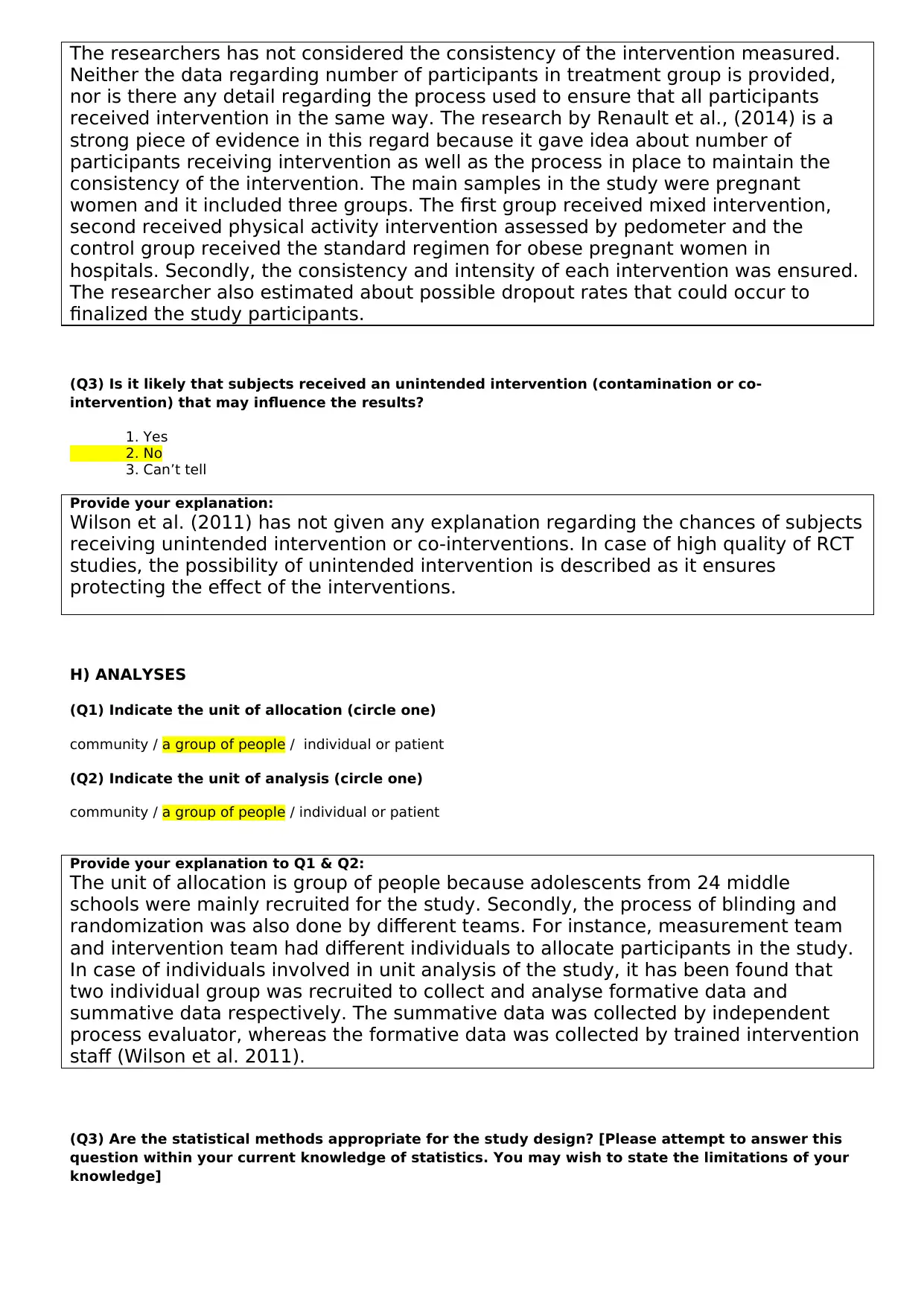
The researchers has not considered the consistency of the intervention measured.
Neither the data regarding number of participants in treatment group is provided,
nor is there any detail regarding the process used to ensure that all participants
received intervention in the same way. The research by Renault et al., (2014) is a
strong piece of evidence in this regard because it gave idea about number of
participants receiving intervention as well as the process in place to maintain the
consistency of the intervention. The main samples in the study were pregnant
women and it included three groups. The first group received mixed intervention,
second received physical activity intervention assessed by pedometer and the
control group received the standard regimen for obese pregnant women in
hospitals. Secondly, the consistency and intensity of each intervention was ensured.
The researcher also estimated about possible dropout rates that could occur to
finalized the study participants.
(Q3) Is it likely that subjects received an unintended intervention (contamination or co-
intervention) that may influence the results?
1. Yes
2. No
3. Can’t tell
Provide your explanation:
Wilson et al. (2011) has not given any explanation regarding the chances of subjects
receiving unintended intervention or co-interventions. In case of high quality of RCT
studies, the possibility of unintended intervention is described as it ensures
protecting the effect of the interventions.
H) ANALYSES
(Q1) Indicate the unit of allocation (circle one)
community / a group of people / individual or patient
(Q2) Indicate the unit of analysis (circle one)
community / a group of people / individual or patient
Provide your explanation to Q1 & Q2:
The unit of allocation is group of people because adolescents from 24 middle
schools were mainly recruited for the study. Secondly, the process of blinding and
randomization was also done by different teams. For instance, measurement team
and intervention team had different individuals to allocate participants in the study.
In case of individuals involved in unit analysis of the study, it has been found that
two individual group was recruited to collect and analyse formative data and
summative data respectively. The summative data was collected by independent
process evaluator, whereas the formative data was collected by trained intervention
staff (Wilson et al. 2011).
(Q3) Are the statistical methods appropriate for the study design? [Please attempt to answer this
question within your current knowledge of statistics. You may wish to state the limitations of your
knowledge]
Neither the data regarding number of participants in treatment group is provided,
nor is there any detail regarding the process used to ensure that all participants
received intervention in the same way. The research by Renault et al., (2014) is a
strong piece of evidence in this regard because it gave idea about number of
participants receiving intervention as well as the process in place to maintain the
consistency of the intervention. The main samples in the study were pregnant
women and it included three groups. The first group received mixed intervention,
second received physical activity intervention assessed by pedometer and the
control group received the standard regimen for obese pregnant women in
hospitals. Secondly, the consistency and intensity of each intervention was ensured.
The researcher also estimated about possible dropout rates that could occur to
finalized the study participants.
(Q3) Is it likely that subjects received an unintended intervention (contamination or co-
intervention) that may influence the results?
1. Yes
2. No
3. Can’t tell
Provide your explanation:
Wilson et al. (2011) has not given any explanation regarding the chances of subjects
receiving unintended intervention or co-interventions. In case of high quality of RCT
studies, the possibility of unintended intervention is described as it ensures
protecting the effect of the interventions.
H) ANALYSES
(Q1) Indicate the unit of allocation (circle one)
community / a group of people / individual or patient
(Q2) Indicate the unit of analysis (circle one)
community / a group of people / individual or patient
Provide your explanation to Q1 & Q2:
The unit of allocation is group of people because adolescents from 24 middle
schools were mainly recruited for the study. Secondly, the process of blinding and
randomization was also done by different teams. For instance, measurement team
and intervention team had different individuals to allocate participants in the study.
In case of individuals involved in unit analysis of the study, it has been found that
two individual group was recruited to collect and analyse formative data and
summative data respectively. The summative data was collected by independent
process evaluator, whereas the formative data was collected by trained intervention
staff (Wilson et al. 2011).
(Q3) Are the statistical methods appropriate for the study design? [Please attempt to answer this
question within your current knowledge of statistics. You may wish to state the limitations of your
knowledge]
⊘ This is a preview!⊘
Do you want full access?
Subscribe today to unlock all pages.

Trusted by 1+ million students worldwide

1. Yes
2. No
3. Can’t tell
Provide your explanation:
After delivering the intervention to treatment and control groups, Wilson et al.
(2011) used two steps for data analysis. The first included dealing with missing data
and the second included analyses of outcome measures of the outcome trial. The
statistical model was used to adjust for baseline values of MVPA (moderate to
vigorous physical activity) and this was included as covariate in the analyses. The
use of this approach is useful in research studies because covariate is a variable
that is predictive of the outcome of the study. In this study, the baseline values of
MVPA can give idea about conflicting variable in the study. In addition, construct
validity and reliable coefficient for the study was evaluated and treatment effect
was evaluated with a t-test.
The purpose of construct validity is to measure to the degree to which an
intervention can measure what it claimed in the study. Hence, in this terms it can be
said that the statistical measures used was appropriate for the study (Ary et al.,
2013). Despite this statement, ‘yes’ response is not given for the question because
this justification was mainly given by reviewing the definition of the terms like
‘construct validity’ and ‘covariate’, however I do not have proper concepts regarding
the appropriate statistical methods that can be used to analyse the research data.
(Q4) Is the analysis performed by intervention allocation status (i.e. intention to treat) rather than
the actual intervention received?
1. Yes
2. No
3. Can’t tell
Provide your explanation:
No, the analysis is not performed on the basis of intervention allocation status,
instead it has been done by considering the actual intervention received. This can
be said because the author had affirmed that the data analysis was done to find out
the increase in MVPA in students assigned to the PA intervention after the
completion of the after-school program. This is an indication that data were
assessed for those participants who received the intervention.
GLOBAL RATING
COMPONENT RATINGS
Please transcribe the information from the grey boxes on pages 1-4 onto this page. See dictionary on how to rate
this section.
A SELECTION BIAS STRONG MODERATE WEAK
1 2 3
B STUDY DESIGN STRONG MODERATE WEAK
1 2 3
C CONFOUNDERS STRONG MODERATE WEAK
2. No
3. Can’t tell
Provide your explanation:
After delivering the intervention to treatment and control groups, Wilson et al.
(2011) used two steps for data analysis. The first included dealing with missing data
and the second included analyses of outcome measures of the outcome trial. The
statistical model was used to adjust for baseline values of MVPA (moderate to
vigorous physical activity) and this was included as covariate in the analyses. The
use of this approach is useful in research studies because covariate is a variable
that is predictive of the outcome of the study. In this study, the baseline values of
MVPA can give idea about conflicting variable in the study. In addition, construct
validity and reliable coefficient for the study was evaluated and treatment effect
was evaluated with a t-test.
The purpose of construct validity is to measure to the degree to which an
intervention can measure what it claimed in the study. Hence, in this terms it can be
said that the statistical measures used was appropriate for the study (Ary et al.,
2013). Despite this statement, ‘yes’ response is not given for the question because
this justification was mainly given by reviewing the definition of the terms like
‘construct validity’ and ‘covariate’, however I do not have proper concepts regarding
the appropriate statistical methods that can be used to analyse the research data.
(Q4) Is the analysis performed by intervention allocation status (i.e. intention to treat) rather than
the actual intervention received?
1. Yes
2. No
3. Can’t tell
Provide your explanation:
No, the analysis is not performed on the basis of intervention allocation status,
instead it has been done by considering the actual intervention received. This can
be said because the author had affirmed that the data analysis was done to find out
the increase in MVPA in students assigned to the PA intervention after the
completion of the after-school program. This is an indication that data were
assessed for those participants who received the intervention.
GLOBAL RATING
COMPONENT RATINGS
Please transcribe the information from the grey boxes on pages 1-4 onto this page. See dictionary on how to rate
this section.
A SELECTION BIAS STRONG MODERATE WEAK
1 2 3
B STUDY DESIGN STRONG MODERATE WEAK
1 2 3
C CONFOUNDERS STRONG MODERATE WEAK
Paraphrase This Document
Need a fresh take? Get an instant paraphrase of this document with our AI Paraphraser
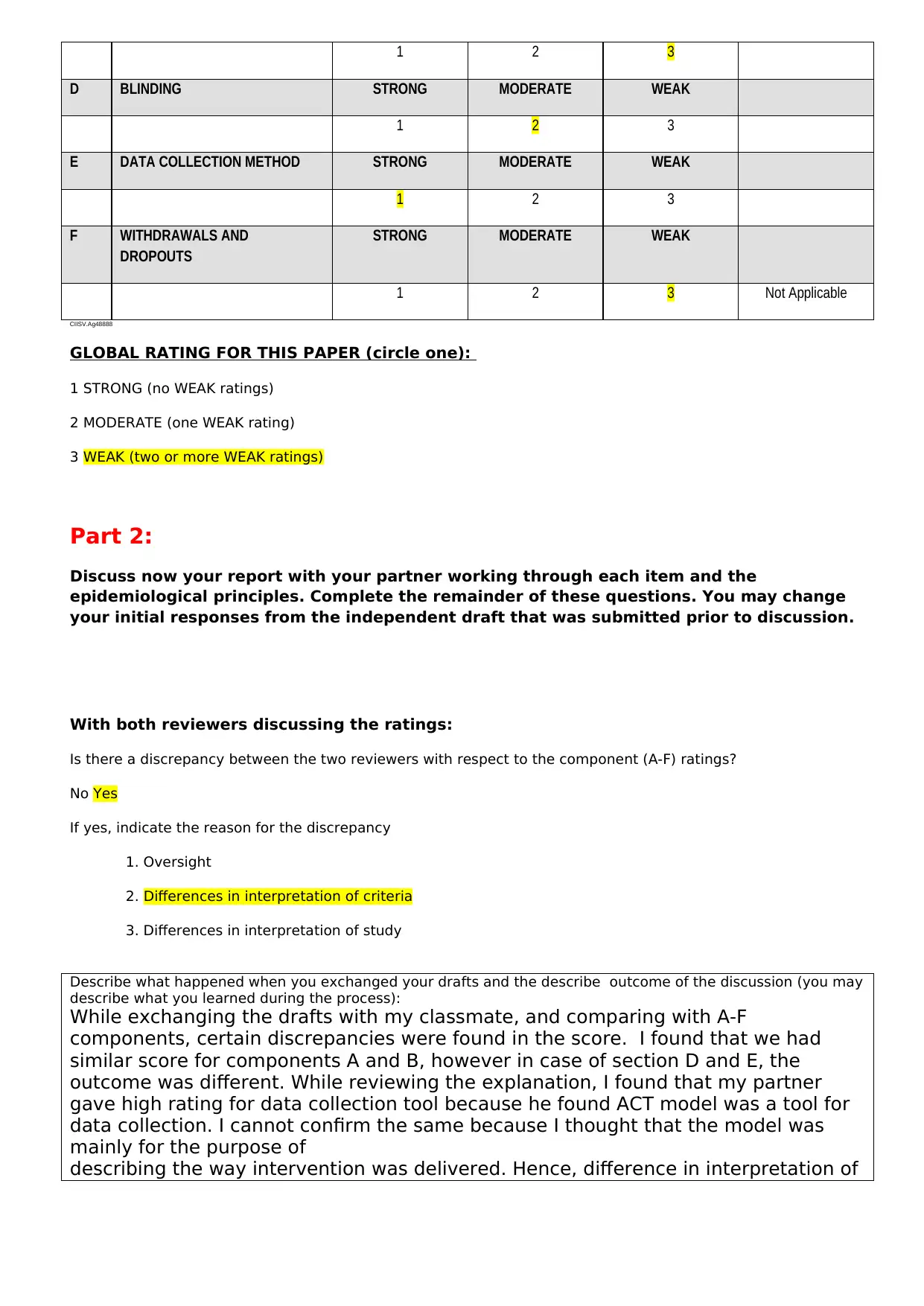
1 2 3
D BLINDING STRONG MODERATE WEAK
1 2 3
E DATA COLLECTION METHOD STRONG MODERATE WEAK
1 2 3
F WITHDRAWALS AND
DROPOUTS
STRONG MODERATE WEAK
1 2 3 Not Applicable
CIISV.Ag48888
GLOBAL RATING FOR THIS PAPER (circle one):
1 STRONG (no WEAK ratings)
2 MODERATE (one WEAK rating)
3 WEAK (two or more WEAK ratings)
Part 2:
Discuss now your report with your partner working through each item and the
epidemiological principles. Complete the remainder of these questions. You may change
your initial responses from the independent draft that was submitted prior to discussion.
With both reviewers discussing the ratings:
Is there a discrepancy between the two reviewers with respect to the component (A-F) ratings?
No Yes
If yes, indicate the reason for the discrepancy
1. Oversight
2. Differences in interpretation of criteria
3. Differences in interpretation of study
Describe what happened when you exchanged your drafts and the describe outcome of the discussion (you may
describe what you learned during the process):
While exchanging the drafts with my classmate, and comparing with A-F
components, certain discrepancies were found in the score. I found that we had
similar score for components A and B, however in case of section D and E, the
outcome was different. While reviewing the explanation, I found that my partner
gave high rating for data collection tool because he found ACT model was a tool for
data collection. I cannot confirm the same because I thought that the model was
mainly for the purpose of
describing the way intervention was delivered. Hence, difference in interpretation of
D BLINDING STRONG MODERATE WEAK
1 2 3
E DATA COLLECTION METHOD STRONG MODERATE WEAK
1 2 3
F WITHDRAWALS AND
DROPOUTS
STRONG MODERATE WEAK
1 2 3 Not Applicable
CIISV.Ag48888
GLOBAL RATING FOR THIS PAPER (circle one):
1 STRONG (no WEAK ratings)
2 MODERATE (one WEAK rating)
3 WEAK (two or more WEAK ratings)
Part 2:
Discuss now your report with your partner working through each item and the
epidemiological principles. Complete the remainder of these questions. You may change
your initial responses from the independent draft that was submitted prior to discussion.
With both reviewers discussing the ratings:
Is there a discrepancy between the two reviewers with respect to the component (A-F) ratings?
No Yes
If yes, indicate the reason for the discrepancy
1. Oversight
2. Differences in interpretation of criteria
3. Differences in interpretation of study
Describe what happened when you exchanged your drafts and the describe outcome of the discussion (you may
describe what you learned during the process):
While exchanging the drafts with my classmate, and comparing with A-F
components, certain discrepancies were found in the score. I found that we had
similar score for components A and B, however in case of section D and E, the
outcome was different. While reviewing the explanation, I found that my partner
gave high rating for data collection tool because he found ACT model was a tool for
data collection. I cannot confirm the same because I thought that the model was
mainly for the purpose of
describing the way intervention was delivered. Hence, difference in interpretation of
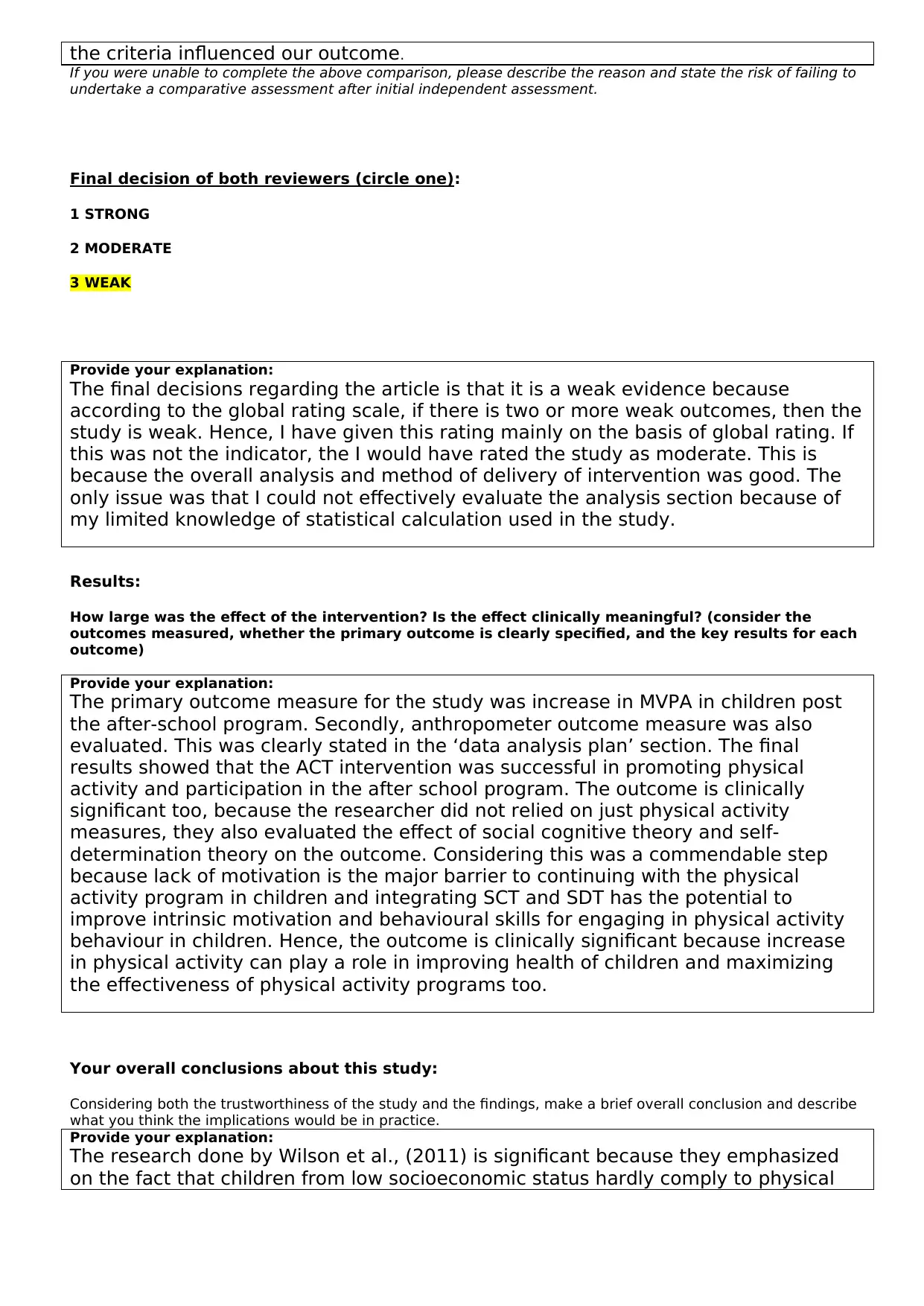
the criteria influenced our outcome.
If you were unable to complete the above comparison, please describe the reason and state the risk of failing to
undertake a comparative assessment after initial independent assessment.
Final decision of both reviewers (circle one):
1 STRONG
2 MODERATE
3 WEAK
Provide your explanation:
The final decisions regarding the article is that it is a weak evidence because
according to the global rating scale, if there is two or more weak outcomes, then the
study is weak. Hence, I have given this rating mainly on the basis of global rating. If
this was not the indicator, the I would have rated the study as moderate. This is
because the overall analysis and method of delivery of intervention was good. The
only issue was that I could not effectively evaluate the analysis section because of
my limited knowledge of statistical calculation used in the study.
Results:
How large was the effect of the intervention? Is the effect clinically meaningful? (consider the
outcomes measured, whether the primary outcome is clearly specified, and the key results for each
outcome)
Provide your explanation:
The primary outcome measure for the study was increase in MVPA in children post
the after-school program. Secondly, anthropometer outcome measure was also
evaluated. This was clearly stated in the ‘data analysis plan’ section. The final
results showed that the ACT intervention was successful in promoting physical
activity and participation in the after school program. The outcome is clinically
significant too, because the researcher did not relied on just physical activity
measures, they also evaluated the effect of social cognitive theory and self-
determination theory on the outcome. Considering this was a commendable step
because lack of motivation is the major barrier to continuing with the physical
activity program in children and integrating SCT and SDT has the potential to
improve intrinsic motivation and behavioural skills for engaging in physical activity
behaviour in children. Hence, the outcome is clinically significant because increase
in physical activity can play a role in improving health of children and maximizing
the effectiveness of physical activity programs too.
Your overall conclusions about this study:
Considering both the trustworthiness of the study and the findings, make a brief overall conclusion and describe
what you think the implications would be in practice.
Provide your explanation:
The research done by Wilson et al., (2011) is significant because they emphasized
on the fact that children from low socioeconomic status hardly comply to physical
If you were unable to complete the above comparison, please describe the reason and state the risk of failing to
undertake a comparative assessment after initial independent assessment.
Final decision of both reviewers (circle one):
1 STRONG
2 MODERATE
3 WEAK
Provide your explanation:
The final decisions regarding the article is that it is a weak evidence because
according to the global rating scale, if there is two or more weak outcomes, then the
study is weak. Hence, I have given this rating mainly on the basis of global rating. If
this was not the indicator, the I would have rated the study as moderate. This is
because the overall analysis and method of delivery of intervention was good. The
only issue was that I could not effectively evaluate the analysis section because of
my limited knowledge of statistical calculation used in the study.
Results:
How large was the effect of the intervention? Is the effect clinically meaningful? (consider the
outcomes measured, whether the primary outcome is clearly specified, and the key results for each
outcome)
Provide your explanation:
The primary outcome measure for the study was increase in MVPA in children post
the after-school program. Secondly, anthropometer outcome measure was also
evaluated. This was clearly stated in the ‘data analysis plan’ section. The final
results showed that the ACT intervention was successful in promoting physical
activity and participation in the after school program. The outcome is clinically
significant too, because the researcher did not relied on just physical activity
measures, they also evaluated the effect of social cognitive theory and self-
determination theory on the outcome. Considering this was a commendable step
because lack of motivation is the major barrier to continuing with the physical
activity program in children and integrating SCT and SDT has the potential to
improve intrinsic motivation and behavioural skills for engaging in physical activity
behaviour in children. Hence, the outcome is clinically significant because increase
in physical activity can play a role in improving health of children and maximizing
the effectiveness of physical activity programs too.
Your overall conclusions about this study:
Considering both the trustworthiness of the study and the findings, make a brief overall conclusion and describe
what you think the implications would be in practice.
Provide your explanation:
The research done by Wilson et al., (2011) is significant because they emphasized
on the fact that children from low socioeconomic status hardly comply to physical
⊘ This is a preview!⊘
Do you want full access?
Subscribe today to unlock all pages.

Trusted by 1+ million students worldwide
1 out of 14
Related Documents
Your All-in-One AI-Powered Toolkit for Academic Success.
+13062052269
info@desklib.com
Available 24*7 on WhatsApp / Email
![[object Object]](/_next/static/media/star-bottom.7253800d.svg)
Unlock your academic potential
Copyright © 2020–2025 A2Z Services. All Rights Reserved. Developed and managed by ZUCOL.




